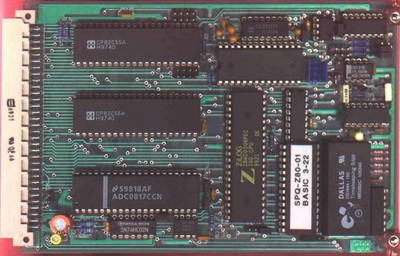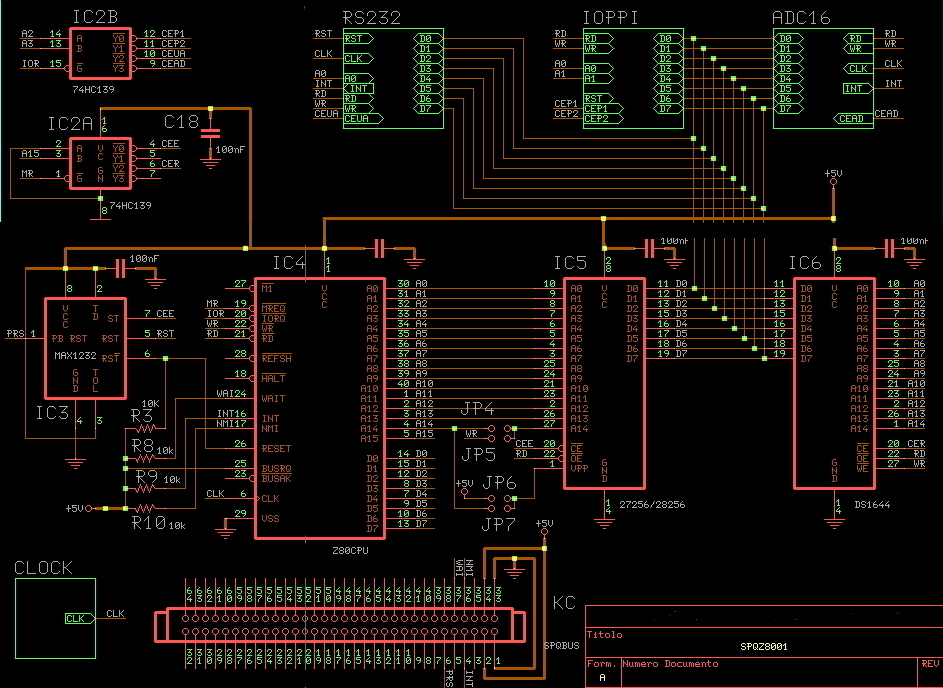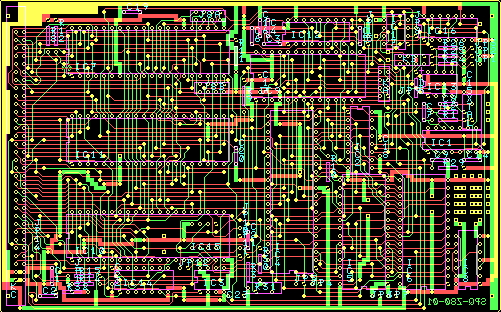Z80-based microcomputer
SPQ-Z80 microcomputer board

GENERAL DESCRIPTION
The SPQ-Z80 is a single-board microcomputer Eurocard format, with the option of a BASIC interpreter on EPROM (EEPROM), suitable for the implementation of data acquisition systems and automation in general. It uses the Zilog Z84C000 microprocessor, well known, documented and compatible at the object code level with the microprocessors of the Z80 and Z80180 family such as HD64180 Hitaci and NSC800 National.The main feature of the SPQ-Z80 is that it can be programmed in BASIC only with the aid of a PC or video terminal. The resident BASIC allows the management of all the hardware resources of the board and can call assembler routines through the CALL instruction; Data retention is ensured by a 32k x 8 Dallas DS1644 NVRAM with real time clock. Alternatively, a powerful NoICE PC remote monitor / debugger is available for developing and debugging code in assembler. The hardware architecture of the board consists of:
- Z84C000 Zilog MPU clocked at 6 MHz, 32K NVRAM / EPROM (EEPROM),
- an 8-bit analog / digital converter with 16 input channels (ADC0816)
- a precision reference generator
- one RS-232C serial port (82C51)
- one RS-485/422 port
- a Centronics parallel port
- 6 programmable 8-bit I / O ports (2 x 82C55)
the board has a 64-pole DIN connector that creates an I / O bus, useful for expansions. These hardware features, combined with the flexibility of the software that makes the source program available in NVRAM for changes even in the field, make the SPQ-Z80 very versatile and suitable for the development of automation and supervision systems, even subject to frequent expansion or modification. The software available to support the card includes: the BASIC interpreter and a micro operating system (MOS) that allows editing at the object code level, a vectorized interrupt management, a real time clock, a driver for LCD and ASCII keyboard, an autoboot and autostart system and various utilities in assembler. A NoICE remote monitor is also available for development in Assembler. From an operational point of view, the use of the SPQ-Z80 is described by the following steps: connecting the SPQ-Z80 to a terminal or PC via the RS232C serial interface; alternatively, it is possible to use an ASCII parallel keyboard with an LCD display connected to the I / O ports as per the attached diagrams. MOS interactive software test with any external hardware required by the application.
TECHNICAL FEATURES
- Z84C0006 CMOS CPU clocked at 2, 4, or 6 MHz
- RAM NVRAM 32k x 8 Dallas DS1644 with real time clock and Lithium battery> = 10 years
- EPROM 32k x 8 EPROM / EEPROM
- ADC0817 16-channel 0-5V analog / digital CONVERTER with built-in multiplexer,
- 8 bit resolution, conversion time 100 microseconds. Power and ground lines
- separate analog.
- LM168 GENERATOR reference voltage for ADC 5.0V - 5ppm / ^ C 0, 0005% / V
- MICROPROCESSOR MONITOR DS1232 power supply voltage monitor (5V + / -5%) e
- watchdog timer with period 1.2 s.
- 2 PARALLEL INTERFACES I / O industry standard 82C55 programmable, for a total of 6
- 8-bit TTL ports
- 1 RS-232C PORT (1200-38600 bps) for communication with PC
- 1 RS-485/422 PORT for twisted pair networks (up to 32 SPQ -Z80 cards)
- 64-way DIN 41612 CONNECTOR for I / O connections and expansions on SPQ -BUS
- DIMENSIONS 100 x 160 mm (Eurocard standard).
- POWER SUPPLY 5 V (+/- 5%) 50 mA, + opt. 12V 1 mA (reference A / D converter)
MOS (Micro Operating System)
The BASIC interpreter resident on EPROM (EEPROM) is integrated by a MOS (micro operating system) which, in addition to managing the RS-232C, RS-422 and Centronics interfaces, an ASCII keyboard and an LCD display, has the following commands:
- M: executes a monitor program that allows direct access to the memory locations;
- E: allows you to modify the contents of the open location
- J: determines the execution of the program at the displayed address
- SPACE: increases the address of the location
- A: it determines a restart of the BASIC interpreter, with cancellation of the NVRAM
- B: run BASIC without deleting the RAM is usable only after having initialized the NVRAM limit seen above.
LCD display
An LCD Display can be controlled both in BASIC and in machine language (ASSEMBLER) by means of the routines described in paragraph 4.7.3. To use the LCD by means of the PRINT instruction from BASIC, it is sufficient to enable a flag, by writing data 75 (ASCII code of "K") in location 65030, this flag also enables the Centronics parallel port at the same time. You can position the cursor by writing its position in location 65034, before the PRINT instruction.
Ex .:
10 CALL 880: REM CLEAR LCD
20 POKE 65030,75: REM ENABLE LCD AND CENTRONICS IN BASIC 30 POKE
65034,64: REM CURSOR AT THE BEGINNING OF THE SECOND LINE 40 PRINT "SPQ-Z80 BAS 3.7"
50 POKE 65030,0: REM DISABLE LCD AND CENTRONICS IN BASIC 60 CALL
1168: REM DISPLAYS DATE AND TIME WITH ROUTINE IN ASSEMBLER
Hex keyboard
Following the attached wiring diagram, it is possible to use a hexadecimal keypad with a switch matrix, encoded by a dedicated integrated, to enter data or commands both in BASIC and in the editing mode of the monitor. The keyboard is connected to a parallel port of the PPI1, is normally enabled and is compatible with the simultaneous use of a terminal connected to the RS232C serial port. With a different circuit configuration it is possible to use the same keyboard to manage a vectorized interrupt.


